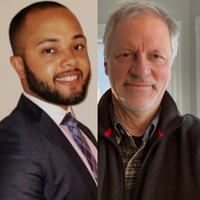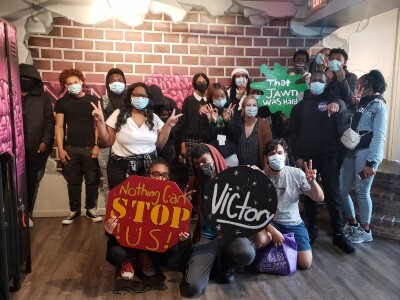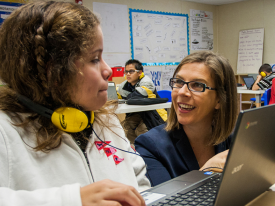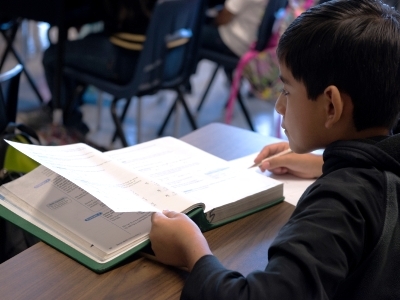5 Lessons (and Counting) from Our Effort to Remake NGLC as an Anti-Racist Organization with Diverse Co-Directors
Topics
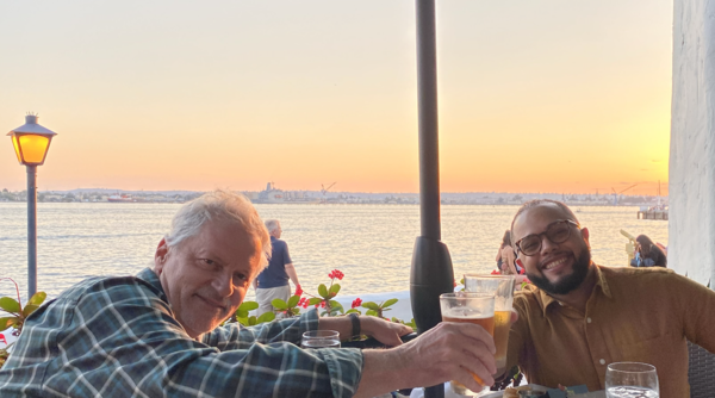
Together, educators are doing the reimagining and reinvention work necessary to make true educational equity possible. Student-centered learning advances equity when it values social and emotional growth alongside academic achievement, takes a cultural lens on strengths and competencies, and equips students with the power and skills to address injustice in their schools and communities.
Our journey isn’t done and may never be. But in launching the transformation of NGLC to explicitly integrate next gen learning with social justice, we are learning a lot that might help other organizations traveling a similar path.
Lesson 1: Honesty → Humility → Vulnerability → Change
Andy: Want to go first?
Carlos: No, you go ahead. I reserve the right to go last!
Andy: OK. Looking back, it could have been seen as possibly the most performative gesture an ed reform organization with an all-White staff could make, in 2020-21: restructure around a co-director model and recruit a global-majority person to co-lead the group. But when NGLC examined our programs, our community, our vision, and our own team last year, we saw a crippling mismatch between our own composition/skillsets/perspectives/life-stories and the work crying out so desperately to be done.
That was the Honesty part: acknowledging that we could not pursue our mission effectively without some fundamental change. As NGLC’s leader since 2012, I felt that I utterly personified that mismatch. Not only as a White, privileged male of advancing age, but as someone with zero direct practitioner experience. That was the Personal Humility part. NGLC needed new leadership for our second decade, and my role in our new structure and culture would depend on my readiness to be a learner.
We understood that the changes we wanted to help catalyze in the field needed to begin at home, with ourselves as individuals and with the nature of our team.
But there was, it’s fair to say, a lot of organizational humility as well. We had been exploring the intersections of equity and next gen learning for a couple of years, at least; one outcome of that work was our organizational Statement on Diversity, Equity, and Inclusion, developed with the help of the nonprofit Promise54, and NGLC’s Designing for Equity toolkit, developed in collaboration with NGLC Regional Funds partners.
It wasn’t enough. We saw that. We understood that the changes we wanted to help catalyze in the field needed to begin at home, with ourselves as individuals and with the nature of our team.
Feeling more than a little vulnerable about how we could make this happen led us back to Promise54 in our search for the next gen learning practitioner, social justice warrior, and liberatory designer we felt we needed. Promise54 was our true ally throughout, listening carefully and helping us interrogate and reimagine key elements of the whole process throughout our six-month engagement with them. Promise54 helped us understand that the real work here lay as much in how we might design and carry out this search, and what we could learn in the process, as it did in actually identifying some promising final candidates. That’s a theme that rings throughout Promise54’s recent blockbuster report, Unrealized Impact 2.0, examining education organizations’ practices with respect to DEIJ—so worth reading for everyone involved in education reform.
Lesson 2: Radical Candor Throughout
Carlos: What Promise54 and NGLC designed together as an interview process built on honesty and vulnerability really shined through from an interviewee perspective. There was a level of critical and open feedback that was required in this process in order for it to work and at its core it required a unique perspective in radical candor. While an easy concept, if there are no structures in place for that radical candor to live in, then it becomes difficult to care personally while challenging directly (see the link). This is most difficult when there are levels of secrecy that do not allow us to be fully connected or responsive to a certain process. When interviewing, this secrecy could surface because of a policy that does not allow us to publicly disclose our intent to leave a job or even a fear of being targeted by an employer should they find out you were even thinking of applying for a new job. This was not at all true for us as we co-engaged in this brand new journey together. It was as much about NGLC as it was about me and there was a level of transparency there I had never experienced before in most interview processes I have been a part of.
I did not feel like a stranger because everyone on the team was committed to this new journey and with an understanding that this would be a fresh new start for us all.
Here I was in my first “informal” conversation with Andy talking about NGLC’s annual revenue and the areas of development that he and others on the team were bringing to the surface. The modeling of this honesty allowed me to feel like I could share my own hesitations and wonders about what I might be getting into. I was able to be radically candid in my feedback about what I was seeing as an outsider and to be fully transparent. Like the fact that I had a few things to say about NGLC’s website and how it was difficult to find things that should not be that hard to find. It was also about NGLC owning the fact that they were navigating new grounds and asking for feedback on the process itself as we went along. I would dare to say that even as I transitioned into this new role that I did not feel like a stranger because everyone on the team was committed to this new journey and with an understanding that this would be a fresh new start for us all.
Andy: I’m glad you brought that up, Carlos—our first conversation. After initial screening with Promise54, each candidate’s first contact with us was to interview me—not the other way around. This was their opportunity to probe whether to continue in the process or not. We did these calls by phone, to lower the Zoom-temperature and make vulnerability (on both ends) easier. I’ve got to say: I have never had a series of first-meetings like this before. Each one felt like it went from 0 to 70 mph on the let’s-be-straight-with-each-other meter within ten minutes.
Carlos: And I’d argue Andy that this was because you created a safe space and structure for these honest conversations to take place. You made it much easier to engage in that conversation because you modeled by thinking critically about your responses and always looking at a spectrum of evidence to give life to your responses.
Lesson 3: The Deep Commitment to Act on DEIJ
Andy: Jal Mehta could have been speaking directly to Team NGLC, in his November 2020 blog post on the NGLC site. “Too much of our current equity work is heavy on talk,” he wrote, “and short on action.” We were feeling the same thing, after publishing four DEIJ commitments in the aftermath of George Floyd’s murder. A core tenet of our own research into a few districts’ successful, enduring efforts to fundamentally transform is that real change begins not when change agents advocate, but when they reflect the transformed mindsets and practices they’re envisioning. They and their organizations need to be the change they are seeking for kids.
As it has always been for us, the educators we work with were showing us the way. Oh, we sure did our share of talking, listening, reading, and book-sharing. But we also experimented. As Jal put it in his blog (paraphrasing Michael Fullan): “While the debate rages about whether actions precede beliefs or beliefs follow from actions, what is clear is that they have to reinforce one another in a virtuous cycle if real change is going to take place.”
So: beliefs + actions. Could we enlist partners like XQ Institute, Fielding International, and Education Reimagined in galvanizing community-wide (or school-wide or family-wide) conversations about the intersection of race and school design? We sure tried. Might we focus the Assessment for Learning Project community (developed with the Center for Innovation in Education, 2Revolutions, and Envision Learning Partners) on rethinking assessment with an anti-racist lens? We tried that, too. Might we challenge our own team to gauge our personal actions on a scale of White-dominant-culture tendencies vs. what Ulcca Joshi Hansen calls “holistic-Indigenous” tendencies? Yes, and holy smackers did that produce some vulnerable conversation.
The parallels with our research on transformation design—and with next gen learning itself—are clear. We all learn and improve most deeply (and are most likely to generate positive outcomes) when we are exploring and applying new “muscles” in real contexts we care about.
Carlos: Sounds to me like you are writing like a true practitioner, Andy! This is exactly what we see in schools, trying to shift from these archaic models of education to where we need to be with students at the center of decision-making processes. And let’s be honest, you can’t really talk about anything without acknowledging our diverse backgrounds. These must carefully balance each other, as Promise54 and NGLC did, and in ways that acknowledge our humanity. I guess I never said thank you, but thank you—to you and to the whole team—for seeing me as me throughout the entire process.
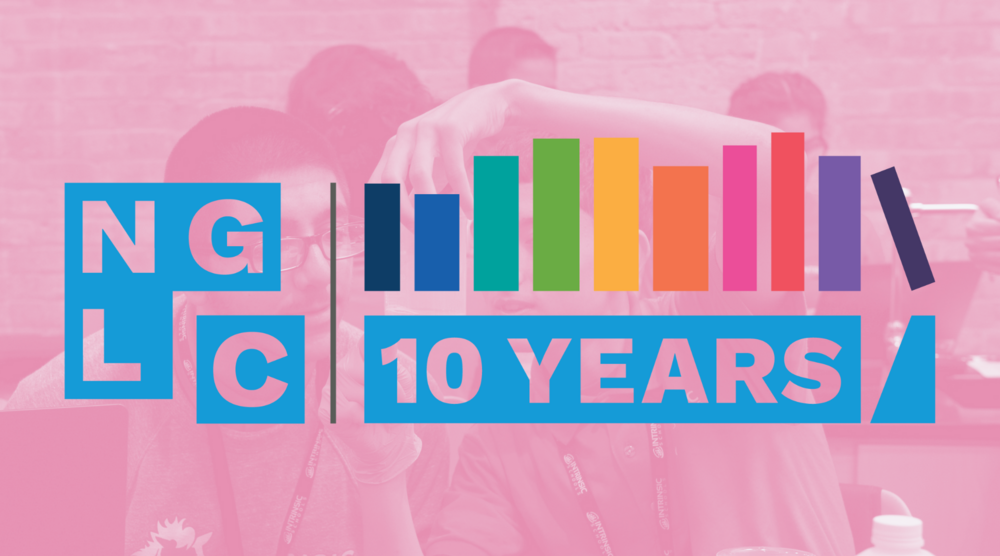
NGLC is making these organizational shifts for DEIJ as we celebrate our community's 10 years of next gen learning innovation and look ahead to the next decade of next gen learning. Join us!
Lesson 4: “Join Our Table!” No: “Let's Co-Design and Co-Lead a NEW Table!"
Carlos: As someone who has engaged in and fully believes in co-creation to bring ideas to life, the idea of co-designing this journey aligned with my values of trust and collaboration. This would all be put to the test as part of our liberatory design work to become an anti-racist organization and allow us to naturally engage in our first truly deep, internal liberatory design for equity process, as a new set of five colleagues from different lived experiences. This whole co-design idea meant that we’d need to engage in a lot of empathy building, that we would need to clearly define and inquire about what has been working or not in the already existing systems and structures that make up NGLC so that we could imagine a new set of possibilities for this new table.
Co-designing a new table was just the right message to reel me into NGLC because from the outset it felt like I was walking into something that would be transformative for all of us on the team. It signaled to me the openness of a team to move beyond where they had been over the previous decade and where they were willing to go in the next one. It meant to me that my ideas would be heard, valued, and respected, which was a main concern of mine as a Dominican American in a predominantly White Anglo-Saxon industry and now the only person of color on the team. This now means that whatever ideas come forth will need to be measured through a new lens of cultural responsiveness and that this new sense-making will encompass the perspective of two co-leaders from two different cultural upbringings.
Andy: The moment Carlos accepted the position, we invited the whole team into the Zoom-room to welcome him and celebrate—with champagne and a toolkit for table-building (though of course presented virtually). It was a good moment for all of us.
Carlos: The Juan Luis Guerra soundtrack was also a nice touch.
Andy: My favorite dance music. Though I look like a stiff White Anglo-Saxon dude, dancing to it!
Carlos: Maybe a few of my DR home-cooked dinners will cure you of that. Someday, when we all start getting together again in person.
Lesson 5: Interrogate Your First Idea about Almost Everything
Andy: This is such a big one. All of us experience the world through schemas we carry around with us—mental models we have developed (or, most often, that we grew up within) that help us make sense of the people and forces and dynamics we encounter. When we say “knee-jerk reaction,” it’s a schema that has prompted that knee-jerk. As a team, NGLC has done some pretty deep work, examining our own schemas. I have now lost count of the number of times I’ve caught myself—or have been called out, invariably with infinite kindness—exhibiting a knee-jerk reaction, or landing on an opinion or initial idea, that carried strong whiffs of White-dominant culture and privilege. Or, at times, just lazy-ass thinking, pure and simple.
So we engaged in a series of “equity pause” conversations that helped us build a practice and mindset we are still working on—one that’s an essential part of liberatory design. Pausing and reflecting on the equity-related aspects of any choice we’re making, or any design we’re co-creating.
In the context of this co-director search and restructuring, that meant, for example:
- Designing our initial job description and invitation radically differently than “the norm,” to convey our vision more compellingly and signal our commitment to rethink traditional practices everywhere they exist (because: what schemas are those practices most likely to reflect?). It began with a word cloud of sought-after attributes—for the new co-director and for all of us, as an organization—and continued with a deck that provided more context.
- Those initial phone calls, the zero-to-70-mph ones. We wanted candidates to know right from the start of the getting-to-know-you that the ball was in their court, and we planned to be a radically open book.
- Having second-interviews take place with other NGLC team members—not me. We intended this as a signal that this was a team-wide enterprise, and we wanted candidates to have a deep exchange with a team member who might report to them. Radical candor has to go upwards, downwards, and sideways in order to work and take root.
- Instead of holding onto our capacities rubric and using it as a scoresheet for candidates, we gave it to them to make the process and our objectives transparent and used it, explicitly, as part of the finalist interviews.
- We made sure to include a member of NGLC’s educator community in finalist interviews as they have valuable, distinct perspectives to offer and perhaps a different lens to use in “seeing” our finalist candidates.
Carlos: COVID gave us all an opportunity, a moment, to break from the traditional and to think creatively about the prospects of what this could mean, moving forward for nonprofits that serve schools and the education sector in general. NGLC took the bull by its horns, it launched itself at this opportunity and, grounded on honesty, humility, and vulnerability, created a change process in hiring and co-boarding more closely aligned to where the organization is going. “Co-boarding” replaced the usual on-boarding as a way of beginning the new-table-building right from the first day. We designed the whole process together. It is through this co-boarding—it’s now been three months since I joined the team—that we have built a solid, inclusive practice that both allows new ideas to flow into the organization and which also hopefully allows any new member who comes into our organization and community to feel like they are truly a part of this movement with us.
We invite organizations out there to truly open themselves up to a space of radical candor and to interrogate those first ideas on which your organization/school/district was founded. Allow yourselves to live in a space of honesty and vulnerability that can help you land in meaningful change for your organization and to better serve those you do this work for.
Andy: I have literally nothing to say or add after that, Carlos. (Which as you know is often not my habit, and is in fact a new practice I’m learning.) Well said.
Carlos: And as you’ve learned about me: I speak from the heart. I hope this blog post has been useful for education groups that, like NGLC, are trying hard to become better, more equity-seeking versions of themselves.
Photo at top: NGLC co-directors Andy Calkins and Carlos Beato meet in person for the first time in San Diego this summer.

